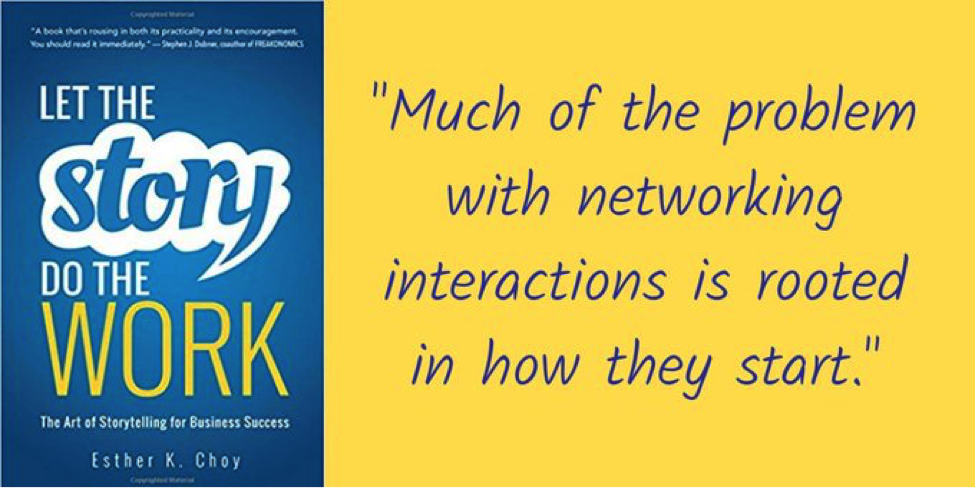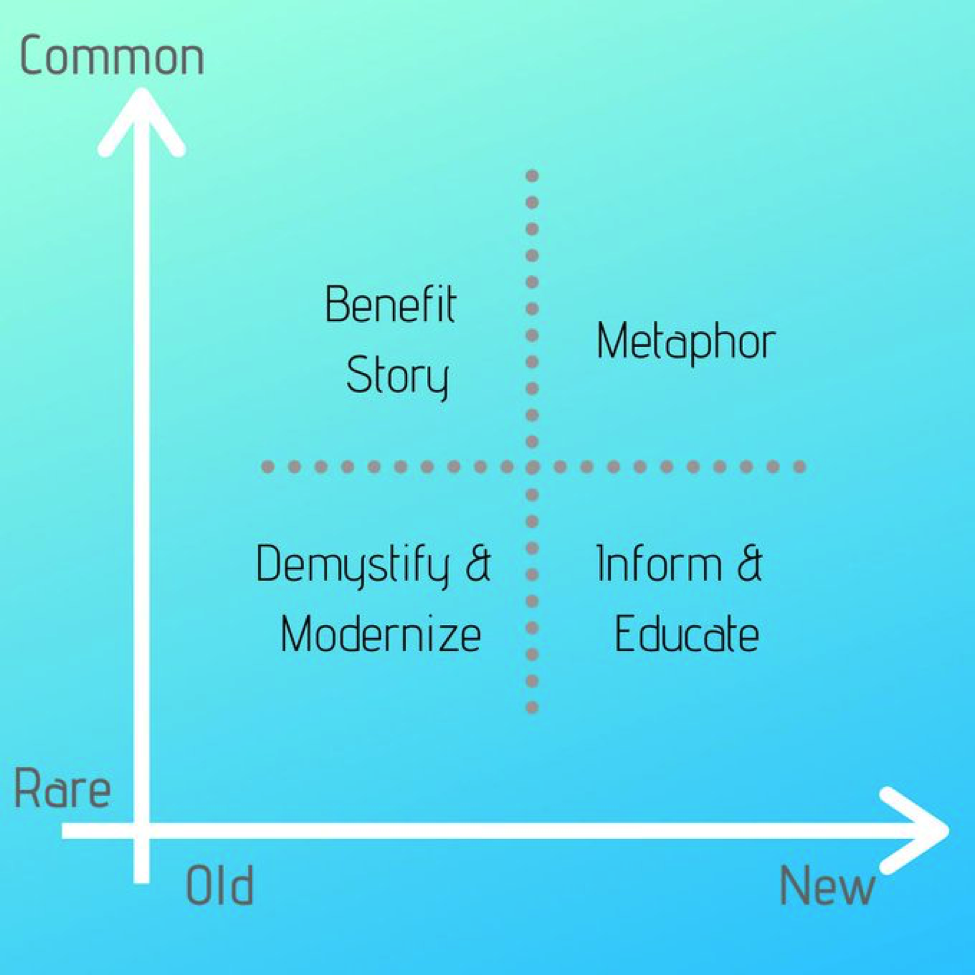January 23, 2020 / Esther Choy

According to informal polls, many people would rather get poked in the eye than attend a networking event. But by using storytelling techniques, you can make networking less torturous and… dare I say… even fun. Networking events can become fun when they break out of the expected ruts and when we begin to learn from each other. Here are five tips for making that happen.
1. Break the Mold
The problem with networking is that our conversations are doomed from the start — because of the way they start. A typical networking conversation starts like this:
“What do you do?”
“I’m the _____ at _____.”
It’s predictable. It’s safe. But it’s so boring.
And while it’s true that disclosing your job title is what the other person asked for, it is actually dangerous to hand them what they want so easily. The danger is that once they get the expected answer, they will stop thinking, imagining and engaging. They feel like they have you figured out, so they start putting you in their preconceived categories. They fill in the blank for you, and decide whether or not to keep talking to you.
So what can you say instead? An expected pattern repeats itself over and over again. After chatting about the weather, the other person asks, “so…what do you do?” When you answer their question, plant a hook. By doing so, you make your conversation partner an active participant in the conversation.
Here’s what I say.“I’m in storytelling.”
Pause.
I don’t give them anything more — until they ask. And if I pause, they will ask because they don’t expect someone to be able to tell stories for a living!
When my conversation partner asks clarifying questions, that means I have their interest. So I tell them a little more.
“Yes, I do storytelling — storytelling for business.”
Pause.
The other person then wants to know how it works, or who I work with, or asks me to tell them more.
So now, I do. Because they’re at the point where they’re starting to wonder what my professional world looks like, what role storytelling can play in business, and how I help my clients. In effect, it’s just like a traditional elevator pitch, but it’s broken in parts based on a natural conversation pattern.
The key is to turn the audience from passive receivers into active investigators.
(Here’s more on how I break the mold at networking events–and how you can too.)
2. Learn.
Psychology professor Carol Dweck of Stanford University told the Harvard Business Review that it’s possible for people to shift their mindsets about networking, so that instead of dreading networking, they see it as a chance to learn. Rather than playing the tape that tells you how awful it’s going to be, Dweck says you can instead tell yourself: “Who knows—it could be interesting. Sometimes when you least expect it, you have a conversation that brings up new ideas and leads to new experiences and opportunities.”
The best way to maximize the chance of learning is to turn yourself into a story collector.
3. Showcase Your Character.
When they want to stand out, many people showcase their credentials. They list off their biggest accomplishments, they name drop who they’ve worked for and the oh-so-impressive alma mater.
But those bright shiny accomplishments make us instantly forgettable. Your character, not your credentials, is what really makes an impression. Think of how you can show off WHO you are rather than WHAT you do. For instance, when one of my clients was facing stiff competition to become an asset manager for a Chinese Sovereign Wealth Fund, he focused on his firm’s stability, soundness and longevity. Their character, represented in this way, is what made the emotional connection with the Chinese Sovereign Wealth Fund, separated them from their competition, and ultimately won the account for them.
When my clients start with their character, audiences remember what they say. Starting with character frees them to start with stories. And information is up to 20 times more memorable when it is conveyed in a story.
My clients notice two other perks when they focus on character. First, their audience literally leans their bodies forward towards them and listens. In today’s world of distractions, this alone is a high achievement. Second, their audience shares their own stories. Their guards lower, and they’re more willing to talk, discuss and collaborate. That sets the ideal tone for networking.
(More on how to showcase your character.)
4. Start Strong.
Your first impression is important, but rather than stress about it, think of how to present yourself in a new way. Tell your story!

5. Reinvent Your Job Description.
Many people feel like their networking conversations are doomed simply by virtue of their profession or job description–it sounds boring, or at least people think they know what it involves as soon as they’ve heard it.
Try a more creative take on your job description:
- “I help keep the internet free.” (Online marketer.)
- “I catch terrorists with spreadsheets.” (Risk management consultant.)
- “I stand between people and prisons.” (Criminal defense attorney.)
- “I protect audiences from boring speakers.” (Speechwriter.)
- “I build financial roadmaps.” (Financial advisor.)
You want to figure out what aspects of your job would interest your audience the most. To do that, consider where your career fits on the following career matrix:
 If your career is a common one with a long history, focus on how it benefits your audience. For instance, being a banker is a fairly common career with a long history. But how many people focus, in their job description, on the benefits this brings others?
If your career is a common one with a long history, focus on how it benefits your audience. For instance, being a banker is a fairly common career with a long history. But how many people focus, in their job description, on the benefits this brings others?
Common new careers can rely on metaphors to quickly convey what you do. To explain a common new career like IT engineer, one of my clients says he’s “the invisible man everyone needs.”
Careers that are old but also rare (such as an acupuncturist) will require you to demystify and modernize the job description so your audience can see how your job can help them in the here and now.
Rare new careers (such as a fashion model or voice actor) will intrigue your audience from the get-go, but you will likely have to educate them about what your field is really like.
By doing the creative work to intrigue your audience, you promise them from the start that a conversation with you will be full of rewarding surprises.
This article is part 2 in our Leadership Storytelling 101 series. Read Part 1 here and Part 3 here.
Related Articles
How to Hook Your Audience’s Attention at a Networking Event
How To Be the First-rate Version of Your Introvert Self
Preparing for an important networking event? We provide customized services to help you do so. Give us a shout! Schedule a complimentary working session with us today. For more tips and insights on storytelling, sign up for our monthly guide. My book, Let the Story Do the Work (published by HarperCollins Leadership), is now available!
Better Every Story
Leadership Transformation through Storytelling
"This is an amazing and insightful post! I hadn’t thought of that so you broadened my perspective. I always appreciate your insight!" - Dan B.
Get Esther Choy’s insights, best practices and examples of great storytelling to your inbox each month.


